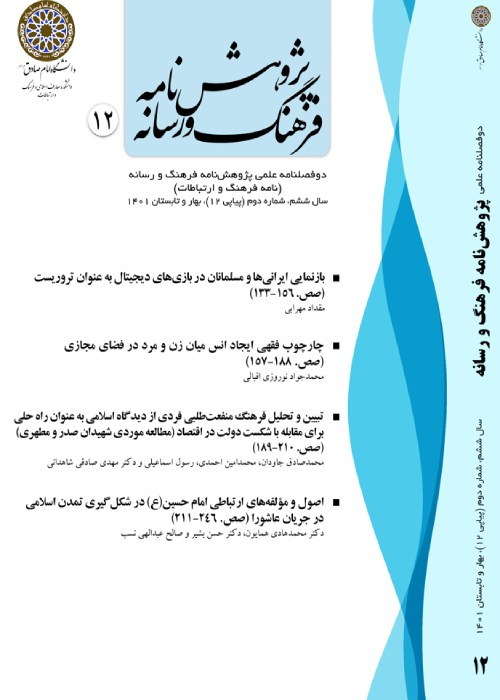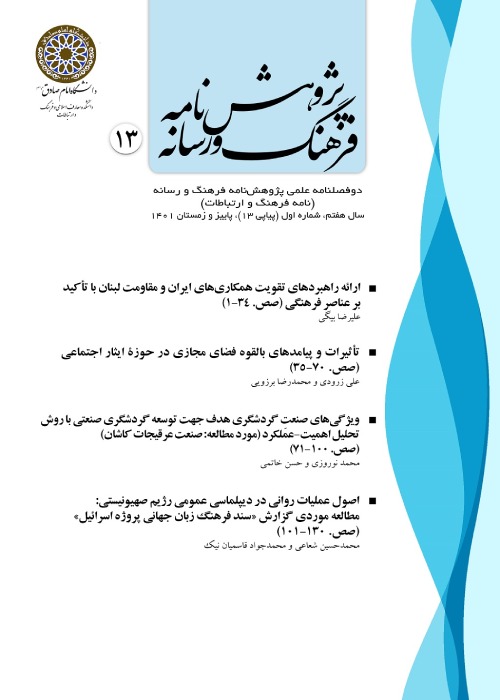فهرست مطالب

پژوهش نامه فرهنگ و رسانه (نامه فرهنگ و ارتباطات)
سال ششم شماره 2 (پیاپی 12، بهار و تابستان 1401)
- تاریخ انتشار: 1402/10/03
- تعداد عناوین: 4
-
صفحات 133-156
جنگ به عنوان یکی از قدیمی ترین مظاهر روابط خصمانه انسانی درونمایه اصلی بسیاری از بازیهای دیجیتال برای جذب مخاطب بیشتر می باشد. به دلیل تبدیل شدن صنعت سرگرمی بازیها به ابزار هژمونیک رضایت آفرین نسبت به اقدامات نظامی آمریکا در کشورهای اسلامی ضرورت پژوهش درباره چگونگی بازنمایی ایرانیها و مسلمانان در بازیهای دیجیتال مضاعف شده است. اکثر پژوهشهای ایرانی، بازنمایی گروه های اقلیت در بازیهای دیجیتال را با روش هایی انجام داده اند که قادر به تشریح این مسیله نیست که چگونه بازیهای دیجیتال در قیاس با رسانه های غیرتعاملی بازنمایی را انجام می دهد. در این مقاله با تحلیل ویژگیهای ساختاری بازیهای رایج از جمله "فراخوانی به خدمت: جنگاوری مدرن"، بتلفیلد 3"، "اسپلینتر سل: لیست سیاه" نشان می دهیم چگونه فناوری های خاص بازیها جهت بازنمایی ایران و کشورهای اسلامی به عنوان مسلمان تروریست مورد استفاده قرار گرفته است. این روش تحقیق محدودیتهای ادبیات تحقیق را پوشش می دهد. همچنین با تحلیل بازیهای دیجیتال سیاسی "ارتش آمریکا" و "کوماوار" که توسط نهادهای نظامی آمریکا با هدف به خدمت گیری نوجوانان آمریکایی ساخته شده اند نشان می دهیم چگونه ایرانیها و مسلمانان در این بازیها به عنوان تروریست بازنمایی شده اند. مهمترین یافته های این پژوهش نشان می دهد که ویژگیهای ظاهری ضد قهرمانها از جمله نوع پوشش، رنگ پوست چهره، نام ها و محل اختفای آنها کاملا شبیه مسلمانان و ایرانیها در قالب تروریست بازنمایی شده است.
کلیدواژگان: بازی دیجیتال، بازنمایی ایرانی ها و مسلمانان، تروریسم -
صفحات 157-188
با گسترش غیرقابل تصور فضای اینترنت و افزایش شبکه های اجتماعی مجازی، روابط انسانی در فضای مجازی بسیار پیچیده شده است. به همین جهت قطعا ما با یک گسترش ناگهانی روابط میان زنان و مردان مواجه هستیم، به طوری که کنترل آن بسیار مشکل می نمایاند. روند رشد این پدیده در میان شیعیان و ایرانیان نیز سیر صعودی غیرقابل باوری داشته است. از طرف دیگر اسلام، کامل ترین دین الهی است. بنابراین، انتظار آنست که به تمام سوالات و شبهاتی که در عصر حاضر مخصوصا با پیشرفت علم و فناوری ایجاد می شود، پاسخ مناسب و درخوری دهد. فضای مجازی و محیط اینترنت شبهات و سوالات زیادی را در حوزه شرع ایجاد کرده است که در این پژوهش تلاش می شود تا به برخی از این شبهات و سوالات پاسخ داده شود.این مقاله بر آن است که چهارچوب شرعی روابط نامحرمان در فضای مجازی را تبیین کند. برای دستیابی به این منظور عناوین فقهی مرتبط با روابط زن و مرد در محیط مجازی استخراج شده و سپس احکام آن عناوین (که در واقع مربوط به دنیای واقعی هستند) از فتاوا و استفتایات موجود فقهای معاصر آورده شده است. در انتها، تلاش شده آنچه که در شبکه های اجتماعی مجازی می تواند مصداقی از این عناوین باشد، ذکر شود، تا مخاطبان این نوع شبکه ها از سردرگمی درآمده و محدوده روابط زن و مرد را در آن از نظر فقه شیعه درک نمایند.
کلیدواژگان: روابط زن و مرد، ازدواج، اینترنت، انس با نامحرم، چت، فقه ارتباطات، فقه فرهنگ -
صفحات 189-210
به دلایلی از جمله شکست بازار ، کارایی از بازار گرفته می شود، که در این شرایط دولت به عنوان راه حلی برای مقابله با شکست بازار ورود پیدا می کند خود دولت نیز با شکست مواجه می شود. از عوامل اصلی شکست دولت ، منفعت طلبی فردی انسان می باشد. .که با توجه به اهمیت مفهوم منفعت طلبی فردی به عنوان عامل شکست دولت، دیدگاه اسلامی با توجه به نگرش شهیدان صدر و مطهری (ره) بررسی شده است. بدین نحو که دیدگاه شهید مطهری به رابطه دین با منافع فردی و اجتماعی حداقلی و دیدگاه شهید صدر حداکثری است. مدل انضمامی اسلام منفعت فردی را با استفاده از چارچوب امر و نهی دینی، و ارایه شاخص هایی برای گزینش اخلاقی مبتنی بر دین کارگزاران دولت اسلامی، منفعت اجتماعی را نیز در دایره ی منفعت فردی قرار می دهد که از این طریق با مشکل شکست دولت مقابله می کند.
کلیدواژگان: شکست بازار، شکست دولت، منفعت طلبی فردی، منفعت اجتماعی، آزادی اجتماعی و معنوی، دین، فرهنگ -
صفحات 211-247
مقاله حاضر تحقیقی ا ست با رویکرد کیفی و روش داده بنیاد (Grounded Theory) که با نگاهی نوین به پدیده عاشورا، در صدد رسیدن به نقشه ارتباطی امام حسین (ع) در سال 61 هجری بوده است. تا مسیر تمدنی که خداوند متعال، برای آن حضرت ترسیم کرده، را از متن تاریخ استخراج کرده و به این پرسش پاسخ دهد که «اصول و مولفه های ارتباطی امام حسین (ع) در شکل گیری تمدن اسلامی در جریان عاشورا چیست؟»ضرورت انجام این پژوهش از دو جهت بوده است؛ اول آنکه تاکنون مقاله ای که صرفا به متن خود تاریخ با تکیه بر منابع دست اول معتبر پرداخته باشد، در خصوص عاشورا انجام نگرفته است. دوم: اینکه با هدف رسیدن به اصول و مولفه های ارتباطی امام حسین (ع)، اساسا پژوهشی ثبت نشده بود. لذا مقاله حاضر، با روش داده بنیاد انجام گرفته است.محقق ابتدا به بررسی سیره تمدنی انبیاء در قرآن و سپس سیره تمدن سازی پنج تن آل عبا (ع) پرداخته تا مسیر تمدن سازی را در نگاه قرآن کریم و تاریخ اسلام تعریف کند. در نهایت به کمک 31 منبع عاشورایی معتبر به تاریخ امام حسین (ع) پرداخته تا اینکه نهایتا الگوی ارتباطی-تمدنی امام حسین (ع)، استخراج شد. داده های تحقیق در دو دسته زیر طبقه بندی شدند:1) اصول و مولفه های ارتباطی امام حسین (ع) در گفتار (21 زیرگروه): به عنوان مثال «دعوت ها»، «دعاها و نفرین های امام» و... 2) اصول و مولفه های ارتباطی امام حسین (ع) در رفتار (5 زیرگروه): به عنوان نمونه «هیبت ظاهری امام»، «آداب سخنوری و استفاده از اصول اقناع» و...
کلیدواژگان: عاشورا، کربلا، امام حسین(ع)، تمدن، ارتباطات
-
Pages 133-156
Video games have become a popular form of entertainment among different groups of people around the world so that the game industry has become a high competitor of Hollywood movies. War as the old sign of hostile relationship among people has become the main theme of many video games in order to attract more audiences. Research on how Iranians and Muslims are represented in video games has become important because the games have become a hegemonic tool for manufacturing consent about American military actions in Islamic countries. Most Iranian research studies about representation of minorities in video games have used research methods such as discourse analysis, narratology and semiotics. These methods cannot explain how new media technological features in comparison with non-interactive media represent minorities. Our research method contributes to Iranian research studies about representation of minorities in video games. In this research, we have analyzed structural characteristics of popular video games such as “Battlefield 3”, “Splinter Cell: Black List”, and “Call of Duty: Modern Warfare” to explain how game features are used for representation of Muslims and Iranians as terrorists. We have also analyzed political video games such as “America’s Army”, “Kuma/war” and “America’s Army 2: Special Forces” that are manufactured by American military organizations for recruiting American young people in military organizations. We found that antagonists’ appearance, names and cloths are used to represent Iranians and Muslims as terrorists. Political oppsitions between Iranian and Islamic countries with U.S.A are represented as protagenists’ missions
Keywords: video games, video war games, representation, terrorism, Iranians, Muslims -
Pages 157-188
With the unimaginable expansion of the Internet and the rise of virtual social networks, human relationships in cyberspace have become very complex. That is why we are definitely facing a sudden expansion of relations between men and women, which makes it very difficult to control. The growth trend of this phenomenon among Shiites and Iranians has also had an incredible upward trend.Islam, on the other hand, is the most perfect divine religion. Therefore, it is expected that it will answer all the questions and doubts that arise in the present age, especially with the advancement of science and technology. Cyberspace and the Internet environment have created many doubts and questions in the field of sharia, which in this study tries to answer some of these doubts and questions.This article aims to explain the religious framework of intimate relationships in cyberspace. To achieve this, the jurisprudential titles related to the relationship between men and women are extracted in the virtual environment and then the rulings of those titles (which are actually related to the real world) are taken from the existing fatwas and istifta'as of contemporary jurists. Finally, an attempt has been made to mention what can be an example of such titles in virtual social networks, so that the audience of such networks is confused and understands the scope of the relationship between men and women in terms of Shiite jurisprudence.
Keywords: Male-female relationships, marriage, internet, intimacy with non-mahrams, chat, communication jurisprudence, culture jurisprudence -
Pages 189-210
In a conventional economy, market performance is assumed to be optimal, but for reasons such as market failure, market efficiency is taken away, in which case the government enters as a solution to deal with market failure. But then the government itself fails. One of the main causes of government failure is human self-interest. Our method in this research is based on library information and documents and analysis of documents. The results show that the views of Martyr Sadr and Motahhari are different, so that the view of Martyr Motahhari on the relationship between religion and individual and social interests is minimal and the view of Martyr Sadr is maximum. In a concrete model of Islam, using the framework of religious commands and prohibitions, and providing indicators for moral selection based on the religion of the agents of the Islamic State, puts the social interest in the scope of individual interest, thus failing to fail. The government opposes.
Keywords: Market failure, government failure, individual utilitarianism, social utility, social, spiritual freedom, religion, culture -
Pages 211-247
The present study, entitled "The principles and components of communication of Imam Hussein(AS) in civilization during Ashura", is research with a qualitative approach that seeks to achieve the communication plan of Imam Hussein(AS) in the year 61 with a new look at the phenomenon of Ashura which the Almighty God has drawn for that Imam Hussein to answer that question that what the principles and components of communication of Imam Hussein were in civilization during Ashura.The necessity of conducting this research has been in two ways. First, so far no research that has relied solely on the text of history itself and has been far from personal analysis which has been conducted on Ashura. Second, in order to reach the communication model of Imam Hussein, basically no research had been recorded and conducted. so the Grounded Theory method was considered suitable for this research.The researcher first has examined the civilization of the prophets in the Qur'an and the Five members of Al-Abba in the history of Islam to define the path of civilization . While, it was the turn of the history of Imam Hussein through which the 31 sources of Ashura, were carefully analyzed to extract the communication propositions of Imam.Finally, after extracting and classifying the propositions and analyzing them, the datas were classified into the following two categories:1) Principles and communication components of Imam Hussein in speech(21 subgroups): For example, "Invitations", "Prayers and Curses of the Imam", etc.2) Principles and communication components of Imam Hussein in behavior(5 subgroups): For example, "Imam's apparent awe", "Speech and principles of persuasion", etc.
Keywords: Ashura, Karbala, Imam Hussein, Civilization, Communication


